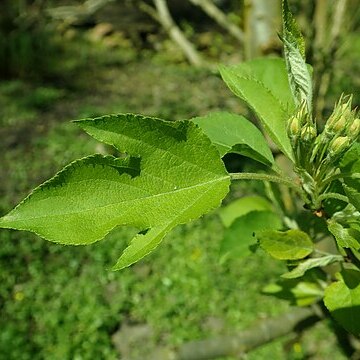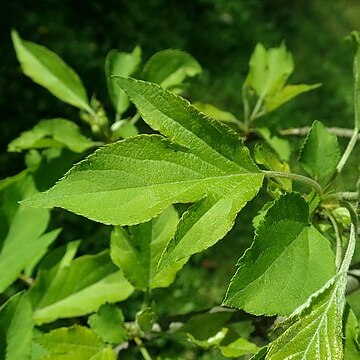Shrubs or small trees, 3–5 m tall; branchlets purplish brown or dark brown when old, terete, puberulous when young, glabrous when old; buds dark purple, ovoid; scales tomentose at margin. Stipules linear-lanceolate, 6–10 mm, herbaceous, sparsely pubescent, margin sparsely glandular denticulate, apex acuminate; petiole 1.5–4 cm, sparsely puberulous; leaf blade ovate or broadly ovate, 5–8 × 4–6 cm, abaxially sparsely puberulous or glabrous, base rounded or truncate, margin doubly serrulate, often 3-lobed, rarely irregularly or not lobed, apex acute or acuminate. Corymb 5–6.5 cm in diam., 4–10-flowered; bracts caducous, linear-lanceolate, membranous, margin entire, apex acuminate. Pedicel 2.5–3.5 cm, sparsely pubescent or glabrous. Flowers 1.5–2 cm in diam. Hypanthium campanulate, abaxially villous or glabrous. Sepals triangular-ovate or triangular-lanceolate, 5–6 mm, ca. as long as or slightly longer than hypanthium, abaxially glabrous, adaxially villous, margin entire, apex acuminate. Petals white, broadly obovate, 0.8–1 cm, base shortly clawed, apex rounded. Stamens 20, unequal, ca. 1/2 as long as petals. Styles (2 or)3(or 4), slightly longer than stamens, glabrous basally. Pome yellowish red, ellipsoid or obovoid, 1–1.5 cm in diam.; sepals caducous; fruiting pedicel 2–3.5 cm. Fl. May–Jun, fr. Jul–Aug. 2n = 34*.
More
A shrubby tree. It grows about 4.5 m tall. The young shoots are red-brown. The leaves are 5-8 cm long. They have 3 to 5 lobes and teeth along the edge. The flowers are white and occur in clusters of 4-10. The flowers are 12 mm wide. The fruit are yellow to purple-red and have a rough surface. They are small.
Can be grown by cuttings or seedlings. Seeds needs stratification.


